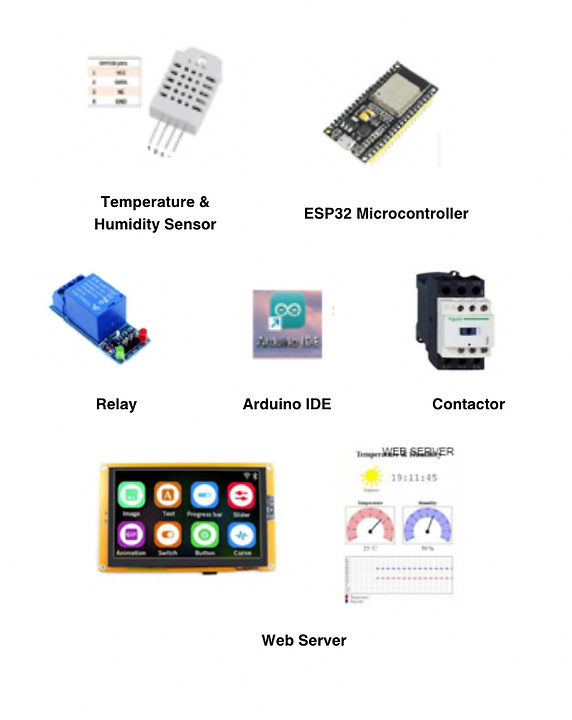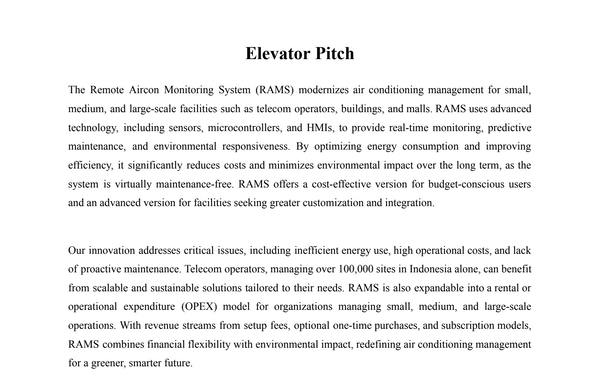Product
The Remote Aircon Monitoring System (RAMS) is an innovative solution that transforms air conditioning management for facilities of all sizes. By integrating advanced sensors, IoT technology, and user-friendly interfaces, RAMS provides real-time monitoring, predictive maintenance, and remote-control capabilities. Our product optimizes energy consumption, reduces operational costs by up to 30%, and minimizes environmental impact. With scalable options ranging from cost-effective setups for small buildings to advanced systems for large-scale operations, RAMS is customizable to meet your specific needs. Experience seamless integration and enhanced efficiency while contributing to a greener planet with RAMS.
Cost-Efficient Version: System Components
-
Modbus Temperature & Humidity Sensor: Monitors real-time environmental conditions in the area where it is placed.
-
HMI Coolmay: Serves as the user interface to display temperature and humidity readings and control the on/off state of the contactor, configurable via GX Works.
-
Contactor: Acts as a high-power switch to control the air conditioner, managed by the HMI Coolmay.
-
GX Works2: PLC software used to program and define the workflow for the HMI Coolmay.
-
Coolmay HMI Software: Used to build and customize the user interface on the HMI device.


Cost-Efficient Version: How It Works
-
Temperature and Humidity Sensors are installed to monitor environmental conditions in real-time. These sensors transmit accurate data on temperature and humidity levels to the Modbus Temperature & Humidity Controller.
-
The Modbus controller sends the collected data to the Coolmay HMI (Human-Machine Interface).
-
The HMI serves as the primary user interface, displaying the data in a user-friendly format and allowing direct adjustments to air conditioning settings.
-
The HMI Coolmay is programmed and customized using GX Works2, a PLC software.
-
Users can define specific thresholds for temperature and humidity levels, ensuring the air conditioner operates within pre-set, optimal ranges.
-
The Contactor, acting as the high-power switch, is controlled by the HMI Coolmay. It switches the air conditioner on or off based on commands sent from the HMI, ensuring efficient energy use and precise control.
Advanced Version: System Components
-
Temperature & Humidity Sensor: Measures environmental conditions such as temperature and humidity in the area where it is placed.
-
ESP32 Microcontroller:
-
Acts as the interface to read temperature and humidity data, which can be displayed on an LCD/HMI or accessed via a web browser.
-
Controls the on/off state of the contactor based on values read from the Modbus temperature sensor or a timer configured through the ESP32 using Arduino IDE.
-
-
Relay: Functions as a switch to turn the contactor on/off. Since the ESP32 output is only 5V DC and cannot directly connect to the contactor, a relay is required to regulate the connection.
-
Contactor: A high-power switch that controls the air conditioning system, managed by the HMI Coolmay.
-
Arduino IDE: Software used for programming the ESP32 microcontroller. It allows users to create, edit, and upload code to the board. Built using Java and equipped with C/C++ libraries, Arduino IDE simplifies input/output operations and enables precise control of the system.


Advanced Version: How It Works
-
Temperature and Humidity Sensors are placed strategically to measure environmental conditions in real-time. These sensors transmit data on temperature and humidity levels from the monitored area.
-
The sensor data is sent to the ESP32 Microcontroller, which acts as the system's central processor. The ESP32 is programmed using Arduino IDE, ensuring it can accurately process the data and manage the system components.
-
Since the ESP32 operates at only 5V DC, a Relay is used to regulate power. The relay bridges the low-voltage ESP32 and the high-power Contactor, which controls the air conditioning unit.
-
The Contactor acts as the physical switch to turn the air conditioner on or off, based on signals from the ESP32. This allows RAMS to control the air conditioning system efficiently based on real-time environmental feedback.
-
The ESP32 can also connect to an LCD screen or web interface, providing users with real-time updates on temperature, humidity, and system status.
-
The advanced version allows for integration with complex systems, including multi-room management and environmental optimization, offering a highly automated solution tailored to small, medium and large-scale or specialized facilities.
System Layout and Design Overview





